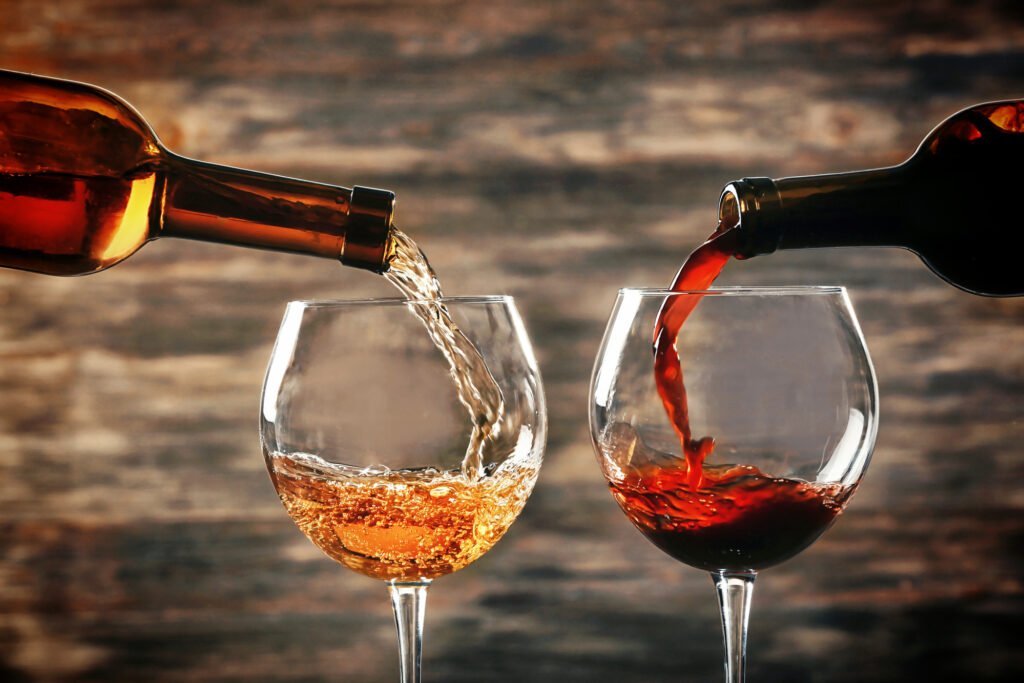What makes you choose between red and white wine is usually your own unique taste. Some wine fans like the bold, full notes of a Cabernet Sauvignon, while others like how a Sauvignon Blanc tastes clean and crisp. But what makes these two types of wine different besides their color and taste?
This article will explain the main differences between red and white wine, such as how they’re made, what flavors they have, and how to pair them with food for the best eating experience. No matter how much you know about wine or if you’re just starting out, knowing these differences can help you make better decisions.
What Defines Red Wine vs White Wine?
The most apparent distinction between red wine vs white wine lies in their color, but the differences go far deeper than appearance.
- Red Wine: Made from dark grapes. The skins of the grapes stay in contact with the juice during fermentation, giving the wine its color. This method also adds tannins, which give the wine structure, depth, and the ability to age.
- White Wine: White wine is made from green or yellow grapes and usually ferments without the skins. This makes the wine lighter in color and crisper in taste. If the skins are taken off early enough in the process, some white wines can also be made from red grapes.
How Red and White Wine Are Made
The method of making wine has a big effect on the taste, texture, and smell of both red and white wines. Here is a list of the changes in production:
How Fermentation Works:
- Red Wine: The skins, seeds, and sometimes stems of the grapes are fermented with the juice to make red wine. This gives the wine color, tannins, and strong tastes.
- White Wine: Most white wines are made without the skins on, which makes them lighter, fruitier, and more acidic.
Aging:
- Red Wine: Oak barrels are often used to age red wine. The tannins, spices, and notes of vanilla, smoke, or spice make the wine more complicated.
- White Wine: Most white wines are kept in tanks made of stainless steel so that they keep their fresh, fruity taste. But Chardonnay and other fuller-bodied whites are aged in wood barrels to make them taste better.
Differences in Taste Between Red and White Wine
Because they are made in different ways, red and white wines have different tastes.
Red Wine Tasting Notes:
- Red wines tend to be fuller, louder, and stronger. They taste like dark fruits like blackberry, plum, or cherry, and they might also have earthy, spicy, or smoky notes.
- Common types of red wine:
- Cab Sauvignon is strong and tannic, with notes of dark fruit and oak.
- Pinot Noir has a light body and smells and tastes like bright red fruits.
- Merlot wine is smooth and easy to drink, with notes of chocolate, plum, and black cherry.
White Wine Tasting Notes:
- With more acidity and bright tastes, white wines tend to be lighter and more refreshing. A lot of the time, they smell like citrus, apple, pear, and tropical foods.
- Well-known types of white wine:
- Sauvignon Blanc is crisp and has green notes and citrusy notes.
- Chardonnay can range from buttery and oaky to crisp and mineral-driven.
- Riesling can be sweet or dry, and it tastes like stone fruits and flowers.
Which Foods Go With Red or White Wine?
Finding out how red and white wines go with different foods is one of the best parts of learning about them.
Red Wine Pairing:
- Red wines go well with hearty, savory foods because they have strong tastes and tannins.
- Best paired with:
- Red meats (beef, lamb)
- Cheeses that have been aged
- Rich pasta meals like bolognese
- Veggies on the grill
White Wine Pairs:
- White wines go well with lighter meals because they are light and acidic.
- Pairs best with:
- Fish and chicken
- Lots of salads and light pasta meals
- Cheeses that are soft, like Brie or Camembert
- Spicy asian food
Good for your health: Red Wine vs. White Wine
Red and white wines are both good for you in small amounts, but they each have different health effects.
Why red wine is good for you:
- It has a lot of antioxidants, like resveratrol, which is good for your heart.
- It has antioxidants in it that can help lower blood pressure and lower cholesterol.
Advantages of white wine for health:
- It has more antioxidants, like tyrosol and hydroxytyrosol, which can help your lungs work better.
- In general, it has fewer calories and less booze than red wine.
Which One Should You Pick: Red or White Wine?
In the end, the choice between red and white wine comes down to personal taste and the social setting. Here are some things to think about:
- Taste Preference: If you like strong, full-bodied tastes, red wine is the way to go. White wine is the way to go if you want something light and cool.
- Food Pairing: Think about the food you’ll be giving. Red wine goes well with hearty dishes, while white wine goes well with lighter meals.
- Season: Red wine is often drunk in the winter because it is rich and warm, while white wine is better on hot summer days.
Conclusion
The Age-Old Question of Red Wine vs. White WineThere is no clear winner in the red wine vs. white wine debate. It depends on the person, the event, and the food that goes with it. You can enjoy a bold glass of Cabernet Sauvignon by the fireplace or a crisp glass of Sauvignon Blanc at a summer picnic. Each type of wine has its own tastes and experiences.
When you know the differences between red and white wine, you can enjoy the depth and variety of the wine world. When you choose a bottle next time, let your tastes and the event guide you, and don’t be afraid to try something from each end of the range!
Also Read: Understanding Champagne’s Alcohol Content: A Complete Guide



